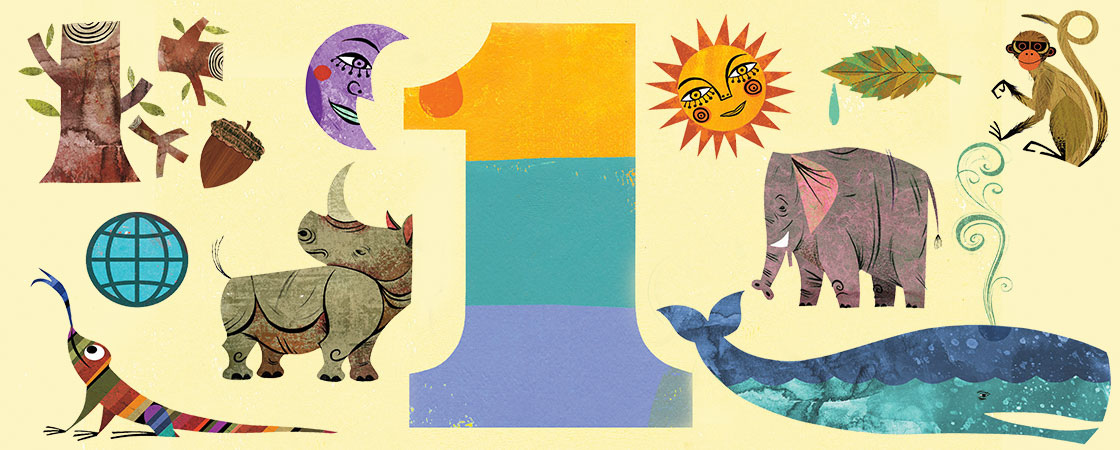One is the sun,
A rhino’s horn;
A drop of dew,
A lizard’s tongue.

A poem that celebrates the special things we find in nature
Learning Objective: Students will examine a poem’s words and structure to determine its theme.
What Is One?
One is the sun,
A rhino’s horn;
A drop of dew,
A lizard’s tongue.
One is the world,
A lonely whale;
An elephant’s trunk,
A monkey’s tail.
One is an acorn,
One is the moon;
One is a forest
Felled too soon.
Your students will love hearing from author and poet Judith Nicholls in this wonderful Q&A. You can click on each question to see the video response or scroll down to read the full transcript.
Connect the poem “What Is One?” to the poem from our October/November 2020 issue: “A Poem From the Treetops.” Ask your students to point out any similarities they see in the two poems.
More About the Article
Content-Area Connections
Science: nature, animals
Social-Emotional Learning: social awareness (expressing gratitude); responsible decision-making (evaluating impacts)
Essential Question
How can we appreciate and protect the unique aspects of nature?
Key Skills
theme, text features, interpreting text, author’s craft, expressing an opinion
1. PREPARING TO READ (10 minutes)
Set a Purpose for Reading
Read aloud the title of the poem and its author’s name, and ask students to predict what the poem might be about.
Read aloud the bubble labeled Big Idea, and instruct students to keep this prompt in mind as they read the poem.
Preview Text Features and Vocabulary
Direct students’ attention to the blue bubble explaining the meaning of felled. Ask them to predict how this word will be used in a poem about special things in nature.
Point out any vocabulary terms that may be challenging for your students, and ask if anyone knows their definitions. Look up their meanings together, as needed.
Ask students to describe the various images in the illustration.
2. READING AND DISCUSSING
Next, ask students to take turns reading aloud each line in the poem.
Close-Reading and Critical-Thinking Questions (30 minutes)
3. SEL FOCUS
What Makes You Unique?
The poem celebrates the uniqueness of various parts of nature, reminding us to appreciate and care for our natural world. Point out that each of your students is one of a kind, a unique piece of the natural world. Ask: What makes you unique? Have students pair off and interview one another then report on what makes their partner unique. Or ask students to share a couple of sentences describing what makes them special.
4. SKILL BUILDING
Featured Skill: Theme
GREAT IDEAS FOR REMOTE LEARNING
Our new Learning Journey Slide Deck (available in your Resources tab) is designed to make your life easier. Have students move through at their own pace or assign smaller chunks for different days. You can also customize the Slide Deck to your liking.
Have students record video or audio of themselves reciting the poem. Invite students to share their recordings with you or, if they would like, with the class.
Before reading the poem, preview the Close-Reading and Critical-Thinking Questions with students to help them know what they should be focusing on as they read. Read the poem aloud as students follow along. Read the poem again, this time pausing to work with the group on each question. Afterward, have students work in pairs to complete the Finding the Big Idea Skill Builder.
The nature words, especially the animal names, in the poem may be unfamiliar to some of your ELL students. Read aloud or play the audio version of the poem. Then read the poem aloud a second time, pausing at the end of each line to ask students to point out the image that goes with each animal or part of nature named in that line of poetry. Invite students to tell what each animal is called in their first language.
Connect this poem to another Storyworks 3 poem, “A Poem From the Treetops,” from our December 2020/January 2021 issue. Ask students to write a paragraph comparing what each poem has to say about nature and how humans should treat it. Instruct your students to pay special attention to the final two lines of each poem.
Have students research an animal or part of nature mentioned in the poem then write a paragraph about what makes it special. Students can include an illustration to go with their writing.